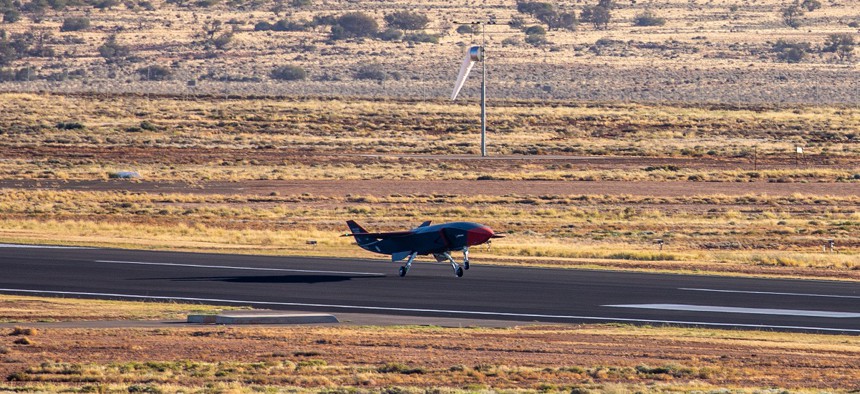
A new Boeing-made drone on its first flight last week. Boeing
AI-Powered Drones Emerge as R&D Priority for Boeing
As the company cuts costs in other areas, a new drone flew for the first time last week.
New technology that allows military drones to fly alongside manned warplanes has emerged as a rare area of corporate investment for Boeing’s defense business amid company-wide cost-cutting initiatives designed to stabilize its commercial jetliner division.
The company announced Tuesday that a new drone equipped with the technology under development for the Australian military flew for the first time last week. Executives see these “loyal wingman” drones as an untapped market with lots of potential.
“The outlook for this market is very promising and we've got investment aligned to support that market outlook,” Jerad Hayes, Boeing’s senior director of autonomous aviation and technology, said on a conference call with reporters. Hayes declined to say how much money Boeing has spent to develop the technology.
The Australian government has purchased six dones as part of its Airpower Teaming System project. In December, the U.S. Air Force awarded Boeing, Kratos, and General Atomics contracts to build prototypes for its own Skyborg project.
Still, some have questioned just how dedicated the Air Force is to the project, which will compete for funding with expensive fighter jets, bombers, and aerial tankers amid an expected decline in defense spending.
“In our opinion, the military can actually move very fast to field a technology when it needs/wants it. This doesn't appear to be one of those times,” Roman Schweizer, a Cowen & Company analyst wrote in a December note to investors. “Last night's awards seem underwhelming given all the hype. We hope something classified is moving faster.”
The Skyborg effort also lost one of its biggest cheerleaders when Will Roper, the former head of Air Force acquisition, departed the Pentagon in January with the turnover of presidential administrations.
The drones, which use artificial intelligence to fly alongside manned fighter jets and other warplanes are seen by some as crucial to future wars.
The investment in the new drone technology comes as the Chicago-based company struggles amid the pandemic’s sharp decline in passenger air travel and the nearly-two-year grounding of its 737 Max airliner following two deadly crashes. The double whammy has prompted the company to lay off tens of thousands of employees, shedding infrastructure and scaling back development efforts.
While Boeing’s defense business has also experienced setbacks — in development of Air Force refueling tankers and a space capsule that is supposed to fly astronauts to the International Space Station — it has had success in developing new T-7 pilot training jets for the Air Force and a new aircraft carrier-based refueling drone for the Navy.
The Australian drone — which is about three-quarters of the size of an F-16 fighter jet — went from concept to first flight in three years.
“We were overjoyed it couldn't have gone much better,” Shane Arnott, director of the Airpower Teaming System program, said on Tuesday’s conference call, said of last week’s test flight.
Program officials attribute the speed in development of the new drone to Boeing’s investments in digital engineering and new manufacturing technologies used in its defense and commercial businesses.
“One of the elements that we're leaning forward on with the Airpower Teaming System is really taking some of those advanced manufacturing capabilities to the next level,” Hayes said.
Arnott said the “scale of investment that Boeing has been able to put into those technologies over others who do talk a lot about it, but maybe haven't got the resources that we do. It's really come to bear particularly on the advanced manufacturing side.”
Since the new drones are considered expendable, designers have wrestled with finding places to cut costs.
“Getting the balance right of 'good enough' has been the main challenge,” Arnott said. “It's kind of easy to chase capability at the expensive cost.”
Unlike fighter jets, the drone uses a commercially available jet engine; Boeing won’t disclose the manufacturer. The company is using robots to build the drone, unlike the labor-intensive human assembly lines of their manned companions.
“For this particular concept to work, it needs to be at a cost point that the customer is willing to lose the aircraft because there is no future scenario in the future fight where there isn't attrition in the airspace,” Arnott said. “The whole idea here is it's better for that to happen in an uncrewed system than a crewed system.”




